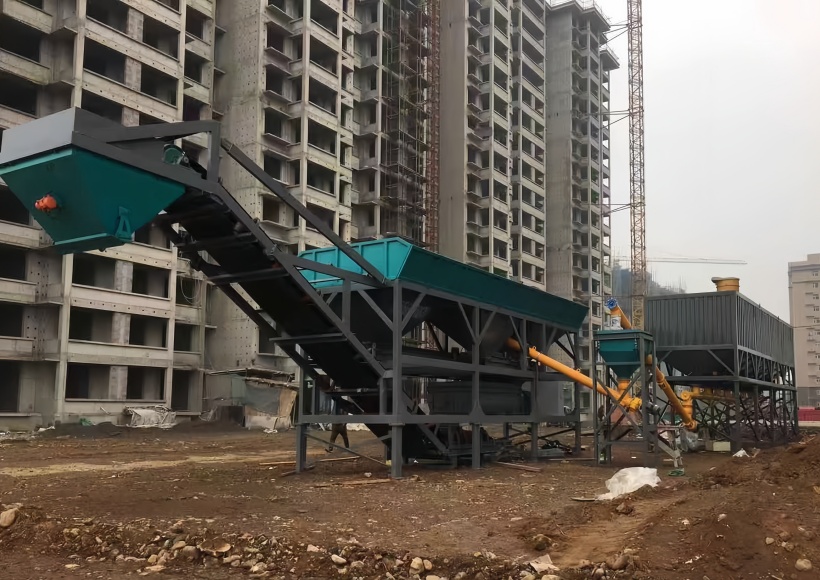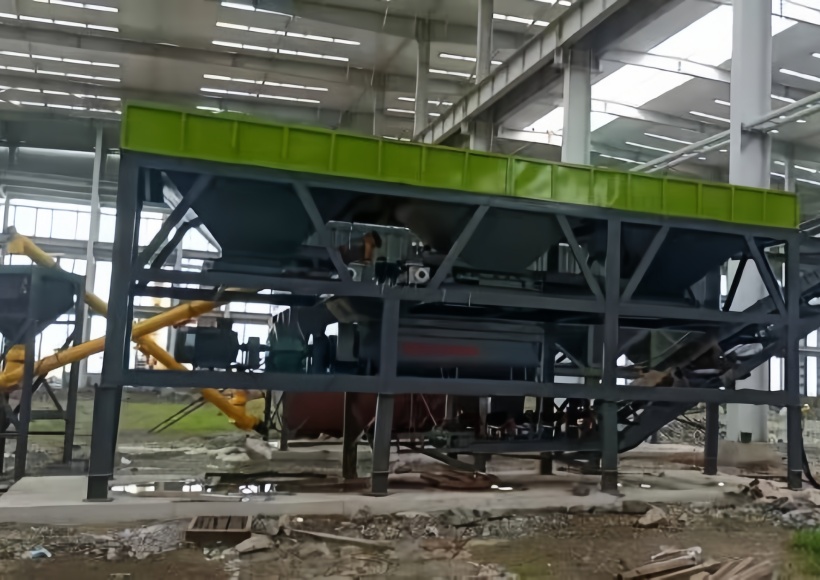Introduction: Core Equipment Selection for Modern Engineering Construction
In today's rapidly developing global infrastructure sector, projects involving highways, railways, airport runways, water conservancy projects, and urban infrastructure development place unprecedented demands on construction efficiency, material quality, and environmental standards. As crucial equipment for producing subgrade materials, the technological advancement of soil stabilization plant sdirectly impacts project quality, timeline, and cost control. In recent years, the "Soil Stabilization Plant All-in-One Machine" has been rapidly replacing tradi tiona l equipment in the global market, becoming the preferred choice for engineering contractors due to its exceptional performance and convenience. This comprehensive guide provides an in-depth analysis of the technical features ofall-in-one soil stabilization plants, details their fundamental differences from traditional
equipment, and offers professional advice for your equipment selection needs.

What is an integrated stabilized soil mixing plant?
Definition and Core Design Philosophy
A Soil Stabilized soil mixing station integrated machine is an advanced mixing equipment developed based on highly integrated and modular design concepts. Through innovative engineering design, it perfectly integrates all independent functional modules of traditional soil stabilization plants - including aggregate batching systems, belt conveyor systems, twin-shaft mixing hosts, powder storage silos, water measurement systems, additive systems, and intelligent control systems - into one or a few compact, easily transportable steel structure modules.
This integrated design represents engineering innovation through precise fluid dynamics calculations and structural optimization rather than simple mechanical combination. During the design phase, the equipment comprehensively considers the entire lifecycle needs of transportation, installation, operation, and maintenance. Utilizing 3D modeling and finite element analysis, it ensures maximum space utilization while maintaining structural strength and operational stability.
Technical Features and Advantages:
The integrated stabilized soil mixing plant features a fully enclosed structure and is equipped with a high-efficiency pulse dust removal system to effectively control dust emissions. Its modular design allows for most assembly and testing to be completed in the factory, while simple on-site installation and connection are all that's needed for operation. An advanced PLC automation control system ensures precise process control and quality monitoring. A touchscreen human-machine interface allows operators to easily set recipe parameters, monitor production status, and access historical data.
Technical characteristics of traditional stabilized soil mixing plants
Structural Characteristics of Traditional Equipment
Traditional stabilized soil mixing plants utilize a fully split design, with each component operating independently, including the batching machine, conveyor belt, main mixer, powder silo, and control room. These components require extensive on-site foundation construction and assembly, typically involving large-scale concrete foundation pouring and extensive steel structure welding and installation.
Limitations of Traditional Equipment
The split design results in a large equipment footprint, high foundation construction costs, and a long installation period (typically 1-2 weeks). Relocation requires complete disassembly of the equipment, the use of multiple transport vehicles, and extensive reinstallation work, taking several weeks and resulting in extremely high relocation costs. Regarding automation, traditional equipment typically utilizes semi-automated control, relying on extensive manual operation, making batching accuracy susceptible to human error.
Comprehensive Analysis of Six Fundamental Differences
Comparison Dimension | Traditional Soil Stabilization Plant | Integrated stabilized soil mixing station |
Structure & Installation | Split-type structure with completely separated functional modules requires massive concrete foundation engineering and 2-4 weeks installation period with extensive on-site work including welding and assembly | Integrated modular structure with main components pre-installed and tested in factory. On-site requires simple hoisting connection, operational within 1-2 days. Simple foundation engineering without on-site welding |
Mobility & Relocation | Extremely difficult relocation requiring complete disassembly, multiple transport vehicles (typically 10-20 truck loads), substantial reinstallation work taking 3-4 weeks. Relocation costs account for 30-50% of equipment value | Efficient and convenient relocation with modular design reducing transport requirements by 60%+, cutting relocation time by 70%+, lowering relocation costs to 10-15% of equipment value. Ideal for multi-site projects |
Automation Level | Limited automation with mostly semi-automatic control relying on manual operations. Batching accuracy susceptible to human factors with limited data recording and analysis capabilities | Intelligent automation with standard full automatic PLC control system featuring remote monitoring, self-diagnosis, production data management, formula storage. High batching accuracy reduces operator requirements by 50%+ |
Investment Cost Analysis | Lower initial equipment investment but high hidden costs including foundation construction ($7143-$21429), installation fees ($4286-$11429), relocation costs (¥100,000-300,000 per move) and labor costs. High overall operating costs | The overall initial investment cost is lower: It significantly saves expenses on foundation construction, equipment installation, and relocation, while greatly reducing labor requirements. Energy consumption is reduced by 20-30%, and the investment payback period is shortened by over 40%, resulting in significantly better overall economic efficiency compared to traditional equipment. |
Environmental Performance | Average environmental performance with dust leakage at component connections, difficult noise control. Additional investment needed for environmental compliance, struggling to meet increasingly strict environmental requirements | Significant environmental advantages with integrated design reducing leakage points. Equipped with high-efficiency centralized dust removal system (≥99.5% efficiency), excellent noise control. Fully meets environmental requirements while improving working conditions |
Maintenance & Upgrades | Inconvenient maintenance with dispersed systems making troubleshooting difficult. Complex component replacement and upgrade challenges requiring extensive on-site modifications | Easy maintenance with modular design facilitating maintenance. Quick and accurate fault diagnosis supporting modular upgrades. Simple component replacement reducing downtime by 50%+ |
Practical Application Case Studies
Case Study 1: Highway Construction Project
An international contractor working on a 120km highway project in Africa divided into 6 sections utilized two all-in-one soil stabilization plants. During the 18-month project period, the equipment was relocated 4 times. Compared to traditional equipment, this saved 84 days in relocation time and approximately $450,000 in relocation costs while improving material quality and production stability.
Case Study 2: Urban Infrastructure Renovation
An urban infrastructure renovation project in a major Asian city faced strict environmental, noise, and construction time limitations due to its downtown location. Using the all-in-one soil stabilization plant not only met environmental requirements but also enabled rapid installation and operation within limited space, significantly shortening the construction period.
How to Choose the Right Equipment?
Key Considerations
1. Project Duration & Mobility: All-in-one machines are preferred for short-term or multi-site projects
2. Environmental Requirements: Choose all-in-one machines for areas with strict environmental regulations
3. Investment Budget: Consider both initial investment and long-term operating costs
4. Technical Capability: Evaluate operator technical skills and training requirements
5. After-sales Service: Consider equipment maintenance and parts availability
Recommended Selection
For most modern engineering projects, particularly those requiring high efficiency, short deadlines, multiple site relocations, or stringent environmental requirements, the all-in-one soil stabilization plant offers superior advantages. It significantly improves construction efficiency, reduces comprehensive operating costs, and better meets the intelligent and environmental requirements of modern engineering construction.

Conclusion: Embracing Technological Development Trends
As the engineering construction industry moves toward intelligent and green development, the soil stabilization plant all-in-onemachine represents the technological development trend of mixing equipment. Its modular design, intelligent control system, and environmental characteristics fully comply with the needs of modern engineering construction, providing contractors with higher economic benefits and market competitiveness.
As professional soil stabilization plant manufacturers, we recommend that investors consider equipment selection from a long-term perspective, choosing technologically advanced and reliable integrated equipment. Tongxin Machinery offer various specifications of all-in-one soil stabilization plants to meet different project scale requirements, providing comprehensive technical support and service guarantees.